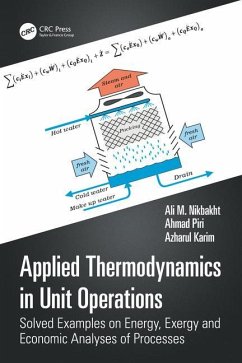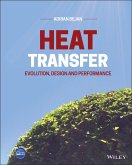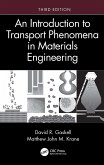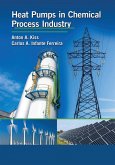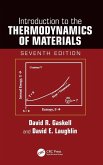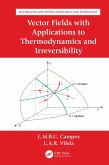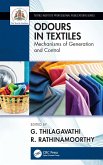Ali M. Nikbakht (School of Mechanical Medical and Process Engineeri, Ahmad Piri (Urm Department of Mechanical Engineering of Biosystems, Azharul Karim (Queensland University of Technology, Brisban, Austra
Applied Thermodynamics in Unit Operations
Solved Examples on Energy, Exergy, and Economic Analyses of Processes
Ali M. Nikbakht (School of Mechanical Medical and Process Engineeri, Ahmad Piri (Urm Department of Mechanical Engineering of Biosystems, Azharul Karim (Queensland University of Technology, Brisban, Austra
Applied Thermodynamics in Unit Operations
Solved Examples on Energy, Exergy, and Economic Analyses of Processes
- Gebundenes Buch
- Merkliste
- Auf die Merkliste
- Bewerten Bewerten
- Teilen
- Produkt teilen
- Produkterinnerung
- Produkterinnerung
The growing demand of energy accounting is the main challenge for engineers working in chemical processing plants, food industries, and the energy sector. This book offers a clear contribution to the quantification of energy consumption in processes, while solving the economic aspects of energy that are vital in real-life industrial contexts.
Andere Kunden interessierten sich auch für
![Heat Transfer Heat Transfer]() Adrian Bejan (Boulder University of Colorado)Heat Transfer124,99 €
Adrian Bejan (Boulder University of Colorado)Heat Transfer124,99 €![An Introduction to Transport Phenomena in Materials Engineering An Introduction to Transport Phenomena in Materials Engineering]() David R. GaskellAn Introduction to Transport Phenomena in Materials Engineering122,99 €
David R. GaskellAn Introduction to Transport Phenomena in Materials Engineering122,99 €![Heat Pumps in Chemical Process Industry Heat Pumps in Chemical Process Industry]() Anton A. KissHeat Pumps in Chemical Process Industry52,99 €
Anton A. KissHeat Pumps in Chemical Process Industry52,99 €![Introduction to the Thermodynamics of Materials Introduction to the Thermodynamics of Materials]() David R. GaskellIntroduction to the Thermodynamics of Materials146,99 €
David R. GaskellIntroduction to the Thermodynamics of Materials146,99 €![Vector Fields with Applications to Thermodynamics and Irreversibility Vector Fields with Applications to Thermodynamics and Irreversibility]() Luis Manuel Braga da Costa Campos (Portugal University of Lisbon)Vector Fields with Applications to Thermodynamics and Irreversibility113,99 €
Luis Manuel Braga da Costa Campos (Portugal University of Lisbon)Vector Fields with Applications to Thermodynamics and Irreversibility113,99 €![Classical and Molecular Thermodynamics of Fluid Systems Classical and Molecular Thermodynamics of Fluid Systems]() Juan H. VeraClassical and Molecular Thermodynamics of Fluid Systems159,99 €
Juan H. VeraClassical and Molecular Thermodynamics of Fluid Systems159,99 €![Odour in Textiles Odour in Textiles]() Odour in Textiles110,99 €
Odour in Textiles110,99 €-
-
-
The growing demand of energy accounting is the main challenge for engineers working in chemical processing plants, food industries, and the energy sector. This book offers a clear contribution to the quantification of energy consumption in processes, while solving the economic aspects of energy that are vital in real-life industrial contexts.
Produktdetails
- Produktdetails
- Verlag: Taylor & Francis Ltd
- Seitenzahl: 316
- Erscheinungstermin: 28. Dezember 2023
- Englisch
- Abmessung: 240mm x 161mm x 22mm
- Gewicht: 622g
- ISBN-13: 9781032543956
- ISBN-10: 1032543957
- Artikelnr.: 68712701
- Herstellerkennzeichnung
- Libri GmbH
- Europaallee 1
- 36244 Bad Hersfeld
- gpsr@libri.de
- Verlag: Taylor & Francis Ltd
- Seitenzahl: 316
- Erscheinungstermin: 28. Dezember 2023
- Englisch
- Abmessung: 240mm x 161mm x 22mm
- Gewicht: 622g
- ISBN-13: 9781032543956
- ISBN-10: 1032543957
- Artikelnr.: 68712701
- Herstellerkennzeichnung
- Libri GmbH
- Europaallee 1
- 36244 Bad Hersfeld
- gpsr@libri.de
Ali M. Nikbakht is an experienced engineer in energy storage systems. He has lectured and conducted industrial engaged research programs at Urmia University and Queensland University of Technology. Having worked in internal combustion engine test rooms, he obtained extensive experience in testing energy systems along with techno-economic assessment of thermal operations. He has presented workshops and seminars in thermal engineering, steam generation and distribution, HVAC and techno-economic evaluations in real-life industrial processes under the framework of 4E (energy, exergy, economy, and environment). He has commissioned the bio-energy laboratory, where solar collector simulator, fluid dynamics experimentation, biomass conversion technologies (pyrolysis and transesterification) are practiced. As a senior consultant in launching engine test room at Urmia University, he has presented novel and innovative approaches for testing, instrumentation and validation. Broad Areas of Research: * Energy storage systems * Techno-economic analysis of energy systems * Computational fluid dynamics in energy systems * Exergy and energy in unit operations and processing industry Ahmad Piri is a postdoctoral fellow at Urmia University, engaged in thermal evaluations of unit operations. He has a demonstrated track record of working in drying, steel, food processing, and chemical industries. Piri has been successful in monitoring the process flow of sugar processing plants and simulation evaporation and crystallization of sugar using thermodynamics and heat/mass transfer principles. He is now consulting the processing plants to develop process flow diagrams and dynamic models by Hysys and EES. Ahmad is a member of a young research team who has initiated a startup on novel drying technologies. His extensive insight on energy calculations has been demonstrated by the stakeholder when giving consultancy to thermal engineering industries. Broad Areas of Research: * Exergy and Thermodynamics * Thermal engineering in fruit/food processing * Steady-state simulation of processes in Hysys Azharul Karim is currently working as a Professor in the School of Mechanical, Medical & Process Engineering (MMPE), Queensland University of Technology (QUT) and the director of Advanced Drying and Sustainable Energy Research (ADSER) Group (https://research.qut.edu.au/adser/). His research is directed towards uncovering fundamental understanding of drying process by developing advanced multiscale and multiphase models using theoretical/computational and experimental methodologies. Through his scholarly, innovative, high quality research, he has established his national and international standing in his field. He has authored over 230 peer-reviewed articles, including 140 high quality Journal Papers, five books and 13 book chapters. His papers have attracted more than 7000 Scholar citations with h-index of 46. He is the editor/board member of six reputed journals including Drying Technology and Nature Scientific Reports. He has been keynote/distinguished speaker at scores of international conferences including International Drying Symposium (2022) and invited/keynote speaker in seminars in many reputed universities including Oxford University (2018) and the University of Illinois (2022). He has been awarded 21 research grants amounting about A$4 million and won multiple international awards for his outstanding contributions in multidisciplinary fields. He is the recipient of highly prestigious ARC Linkage (2021) and ARC Discovery grants (2022) at first chief investigator. He is also a leader in innovative application of 'Lean Manufacturing' concepts in hospital emergency departments to reduce long waiting times and optimize resources. Dr Karim is the inventor of many innovative new products including (1) Ultrasonic washing machine (patent WO02089652) (2) Ultrasonic dishwasher (patent WO0229148) (3) Advanced independent solar drying system (Patent 2019900943) and (4) Integrated heat pump, vacuum and microwave convective drying system (Patent 2019900942). Dr Karim's high-level achievements in both fundamental and applied research in the important area of Advanced Drying and Microwave Heating has established him as one of the world's leading researchers in these fields as demonstrated by his Field Weighted Citation Impacts (FWCI) of 2.24 and 9.82 respectively. Broad Areas of Research: * Multi-scale and Physics Based Modelling in Drying * Renewable Energies and Sustainable Processing * Artificial Intelligence and Advanced Modelling in Agri-industrial Processes * Nano fluid solar thermal storage * Concentrating PV-thermal collector * Thermal Storage * Lean Manufacturing and Lean Healthcare System
Chapter 1. Introduction and Concepts. 1.1. A Short Review of Thermoynamics.
Chapter 2. Mass Balance. 2.1. Mass Flow. 2.2. Volumetric Flow. 2.3. Mass
Balance. 2.4. Material Balance. Chapter 3. Energy Balance. 3.1. Energy
Balance. 3.2. Energy Balance of Closed Systems. 3.3. Thermophysical
Properties. Chapter 4. Entropy. 4.1. Reversible and Irreversible Process.
4.2. Irreversibility Factors. 4.3. Internal and External Irreversibility.
4.4. Entropy. 4.5. Isentropic process. 4.6. Gibbs Equations. 4.7. Entropy
Change of Liquids and Solids. 4.8. Isentropic Processes in Ideal Gases.
4.9. Mechanisms of entropy transfer. 4.10. Entropy balance. Chapter 5.
Exergy. 5.1. Cycle. 5.2. Thermal engine. 5.3. Carnot Cycle. 5.4. Exergy of
heat. 5.5. Exergy of work. 5.6. Exergy of mass. 5.7. Exergy of ideal gas.
5.8. Thermal and mechanical exergy of mass flow. 5.9. Cold and hot exergy.
5.10. Destruction of exergy. 5.11. Exergy balance. Chapter 6. thermodynamic
analyses in unit operations. 6.1. Thermodynamic Analyses. 6.2. Energy
Analysis. 6.3. Exergy Analysis. 6.4. System losses. 6.5. Application of
tehrmodynamics in the food industry. 6.6. Thermophysical Properties of
Agricultural Products and Food. 6.7. Energy analysis in unit operation.
6.8. Reversible work of steady flow. 6.9. Isentropic Efficiency of Steady
Flow Equipment. 6.10. Case examples from the food industry. Chapter 7.
Pschycrometry and Drying. 7.1. Mixture. 7.2. Gas Mixtures. 7.3. Properties
of a Mixture of Ideal Gases. 7.4. Analysis of Humid Air. 7.5. Adiabatic
Saturation Process. 7.6. Psychrometry Chart. 7.7. Thermodynamic Processes
of Humid Air. 7.8. Cooling Tower. 7.9. Exergy of moist air. 7.10. Drying.
Chapter 8. Exergy-Economic Analysis. 8.1. Concepts of exergy-economic
analysis. 8.2. Heat exchanger. 8.3. Pump. 8.4. Mixing. 8.5. Evaporator.
8.6. Separator. 8.7. Throttling valve. References. Appendices
Chapter 2. Mass Balance. 2.1. Mass Flow. 2.2. Volumetric Flow. 2.3. Mass
Balance. 2.4. Material Balance. Chapter 3. Energy Balance. 3.1. Energy
Balance. 3.2. Energy Balance of Closed Systems. 3.3. Thermophysical
Properties. Chapter 4. Entropy. 4.1. Reversible and Irreversible Process.
4.2. Irreversibility Factors. 4.3. Internal and External Irreversibility.
4.4. Entropy. 4.5. Isentropic process. 4.6. Gibbs Equations. 4.7. Entropy
Change of Liquids and Solids. 4.8. Isentropic Processes in Ideal Gases.
4.9. Mechanisms of entropy transfer. 4.10. Entropy balance. Chapter 5.
Exergy. 5.1. Cycle. 5.2. Thermal engine. 5.3. Carnot Cycle. 5.4. Exergy of
heat. 5.5. Exergy of work. 5.6. Exergy of mass. 5.7. Exergy of ideal gas.
5.8. Thermal and mechanical exergy of mass flow. 5.9. Cold and hot exergy.
5.10. Destruction of exergy. 5.11. Exergy balance. Chapter 6. thermodynamic
analyses in unit operations. 6.1. Thermodynamic Analyses. 6.2. Energy
Analysis. 6.3. Exergy Analysis. 6.4. System losses. 6.5. Application of
tehrmodynamics in the food industry. 6.6. Thermophysical Properties of
Agricultural Products and Food. 6.7. Energy analysis in unit operation.
6.8. Reversible work of steady flow. 6.9. Isentropic Efficiency of Steady
Flow Equipment. 6.10. Case examples from the food industry. Chapter 7.
Pschycrometry and Drying. 7.1. Mixture. 7.2. Gas Mixtures. 7.3. Properties
of a Mixture of Ideal Gases. 7.4. Analysis of Humid Air. 7.5. Adiabatic
Saturation Process. 7.6. Psychrometry Chart. 7.7. Thermodynamic Processes
of Humid Air. 7.8. Cooling Tower. 7.9. Exergy of moist air. 7.10. Drying.
Chapter 8. Exergy-Economic Analysis. 8.1. Concepts of exergy-economic
analysis. 8.2. Heat exchanger. 8.3. Pump. 8.4. Mixing. 8.5. Evaporator.
8.6. Separator. 8.7. Throttling valve. References. Appendices
Chapter 1. Introduction and Concepts. 1.1. A Short Review of Thermoynamics.
Chapter 2. Mass Balance. 2.1. Mass Flow. 2.2. Volumetric Flow. 2.3. Mass
Balance. 2.4. Material Balance. Chapter 3. Energy Balance. 3.1. Energy
Balance. 3.2. Energy Balance of Closed Systems. 3.3. Thermophysical
Properties. Chapter 4. Entropy. 4.1. Reversible and Irreversible Process.
4.2. Irreversibility Factors. 4.3. Internal and External Irreversibility.
4.4. Entropy. 4.5. Isentropic process. 4.6. Gibbs Equations. 4.7. Entropy
Change of Liquids and Solids. 4.8. Isentropic Processes in Ideal Gases.
4.9. Mechanisms of entropy transfer. 4.10. Entropy balance. Chapter 5.
Exergy. 5.1. Cycle. 5.2. Thermal engine. 5.3. Carnot Cycle. 5.4. Exergy of
heat. 5.5. Exergy of work. 5.6. Exergy of mass. 5.7. Exergy of ideal gas.
5.8. Thermal and mechanical exergy of mass flow. 5.9. Cold and hot exergy.
5.10. Destruction of exergy. 5.11. Exergy balance. Chapter 6. thermodynamic
analyses in unit operations. 6.1. Thermodynamic Analyses. 6.2. Energy
Analysis. 6.3. Exergy Analysis. 6.4. System losses. 6.5. Application of
tehrmodynamics in the food industry. 6.6. Thermophysical Properties of
Agricultural Products and Food. 6.7. Energy analysis in unit operation.
6.8. Reversible work of steady flow. 6.9. Isentropic Efficiency of Steady
Flow Equipment. 6.10. Case examples from the food industry. Chapter 7.
Pschycrometry and Drying. 7.1. Mixture. 7.2. Gas Mixtures. 7.3. Properties
of a Mixture of Ideal Gases. 7.4. Analysis of Humid Air. 7.5. Adiabatic
Saturation Process. 7.6. Psychrometry Chart. 7.7. Thermodynamic Processes
of Humid Air. 7.8. Cooling Tower. 7.9. Exergy of moist air. 7.10. Drying.
Chapter 8. Exergy-Economic Analysis. 8.1. Concepts of exergy-economic
analysis. 8.2. Heat exchanger. 8.3. Pump. 8.4. Mixing. 8.5. Evaporator.
8.6. Separator. 8.7. Throttling valve. References. Appendices
Chapter 2. Mass Balance. 2.1. Mass Flow. 2.2. Volumetric Flow. 2.3. Mass
Balance. 2.4. Material Balance. Chapter 3. Energy Balance. 3.1. Energy
Balance. 3.2. Energy Balance of Closed Systems. 3.3. Thermophysical
Properties. Chapter 4. Entropy. 4.1. Reversible and Irreversible Process.
4.2. Irreversibility Factors. 4.3. Internal and External Irreversibility.
4.4. Entropy. 4.5. Isentropic process. 4.6. Gibbs Equations. 4.7. Entropy
Change of Liquids and Solids. 4.8. Isentropic Processes in Ideal Gases.
4.9. Mechanisms of entropy transfer. 4.10. Entropy balance. Chapter 5.
Exergy. 5.1. Cycle. 5.2. Thermal engine. 5.3. Carnot Cycle. 5.4. Exergy of
heat. 5.5. Exergy of work. 5.6. Exergy of mass. 5.7. Exergy of ideal gas.
5.8. Thermal and mechanical exergy of mass flow. 5.9. Cold and hot exergy.
5.10. Destruction of exergy. 5.11. Exergy balance. Chapter 6. thermodynamic
analyses in unit operations. 6.1. Thermodynamic Analyses. 6.2. Energy
Analysis. 6.3. Exergy Analysis. 6.4. System losses. 6.5. Application of
tehrmodynamics in the food industry. 6.6. Thermophysical Properties of
Agricultural Products and Food. 6.7. Energy analysis in unit operation.
6.8. Reversible work of steady flow. 6.9. Isentropic Efficiency of Steady
Flow Equipment. 6.10. Case examples from the food industry. Chapter 7.
Pschycrometry and Drying. 7.1. Mixture. 7.2. Gas Mixtures. 7.3. Properties
of a Mixture of Ideal Gases. 7.4. Analysis of Humid Air. 7.5. Adiabatic
Saturation Process. 7.6. Psychrometry Chart. 7.7. Thermodynamic Processes
of Humid Air. 7.8. Cooling Tower. 7.9. Exergy of moist air. 7.10. Drying.
Chapter 8. Exergy-Economic Analysis. 8.1. Concepts of exergy-economic
analysis. 8.2. Heat exchanger. 8.3. Pump. 8.4. Mixing. 8.5. Evaporator.
8.6. Separator. 8.7. Throttling valve. References. Appendices

